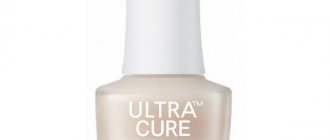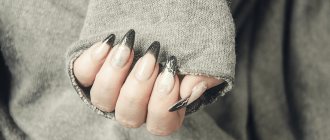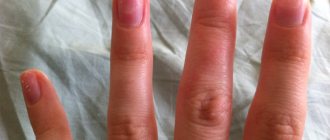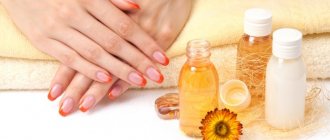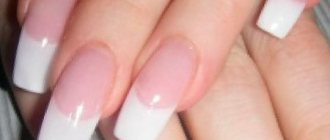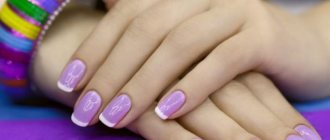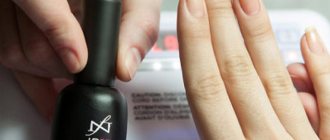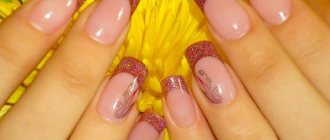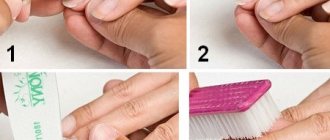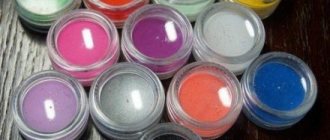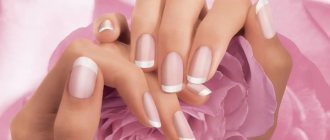Nail extensions are a procedure that allows you to get beautiful, long nails. This is especially convenient for girls with short and brittle nails. Proper nail extensions allow you to get a beautiful manicure, even if the procedure is carried out independently, at home.
Gel nail extension technology at home
You can apply artificial material to your nails at any nail salon. But this can also be done at home. This is especially easy to do for those who have the necessary practical knowledge, a set of materials and tools:
- a special lamp (usually drying with uv radiation so that the polymer hardens);
- gel (the type is selected individually; single-phase, two- or three-phase can be used);
- tools (a basic manicure set or a router with the necessary attachments when choosing a hardware type of manicure, buffs, nail file, etc.).
Using the gel extension procedure, you can achieve nails of any length. You can decorate them with any designs (there is much more room for creativity than on your own nails). Extended nails (if necessary) can be easily coated with any regular varnish. Removing the varnish is as easy as applying it, but the original design will not be damaged.
It is easy for a manicurist to navigate among the materials and choose exactly what is needed in a particular case. How to work with it is also not a problem for a professional. But if the gel is chosen for home use, then all stages of extension must be taken into account in order to obtain a high-quality result.
- Preparation. Here, good preparation of the nail for the subsequent coating is necessary: the cuticle, hangnails and rough skin are removed. The top layer of the nail is sanded to remove the pterygium. Part of the free edge of the nail is cut off so that no more than 1 mm remains. This can be omitted if the gel is applied to strengthen it on a natural nail. Then an antiseptic is applied, and after it dries completely (a couple of seconds), a thin layer of primer is applied.
- Coating. Having chosen the shape or base for the nail, apply the gel in layers with a brush. The first stage is a thin layer of base gel, then it is well baked (this is basic and important for gel nails to last a long time). The second stage is a thick layer of sculpting gel (it is necessary to give the nail plate the planned shape and thickness). This layer must be thoroughly dried so that there is no possibility of deformation during further work. Remove the sticky layer (a popular method at home is the usual nail polish remover).
- Modeling. At this stage, artificial nails begin to take on a more aesthetic appearance. Nails acquire the originally intended shape using a file or a special cutter. Excess material is cut off, requiring careful control of the length and shape of the nails, thickness and the presence of an apex (“mound”).
- Design and completion of work. This stage is more creative in nature than technological. A variety of materials are used: painting, appliqués, inlay with stones, etc. After completing the work, apply protective gel and remove its dispersion layer.
Result of extension
When growing your nails at home, you should pay attention to the quality of drying each layer of gel so that the final result is not disappointing. Also, do not apply the coating too close to the nail bed, so as not to injure it during the coating and modeling process.
And here is the video of the master class:
Extension lesson: French on forms - step by step with photos
Classic French manicure (French) is a plain, discreet background (flesh or pinkish tint) and a clearly drawn white “smile line” along the edge of the nail. The appearance of extended nails has led to a new round of popularity for the French style, which looks especially impressive on nails of a regular geometric shape.
When creating a jacket using molds, it is lined with gel of the selected color.
Stages of performing French on forms:
- Preliminary preparation of nails.
- Installation and adjustment of the form. The edge of the form is placed under the nail, the other edge is fixed on the finger.
- Applying a layer of base gel. To give it a matte finish, you can blot it with a napkin.
- The nail is formed with gel of the selected shade (pinkish, flesh-colored) - up to the border of the future “smile”. “The Smile Line” is laid out very carefully. The surface must be perfectly flat.
- Using a brush, a white gel is used to form a smile contour; the gel is applied close to the main color. The layer is polymerized under a UV lamp for 2 minutes, under an LED lamp for 1 minute.
- Removing the form.
- Grinding the surface and adjusting the edge of the created nail, removing sawed off particles.
- Apply a clear coat for protection and shine.
You can create a French manicure without using white gel. Then a “smile” is drawn on the formed nail with white acrylic paint, and the nail is covered with a protective layer of transparent gel, which polymerizes according to technology.
Types of gels
You can get beautiful nails if you choose a high-quality coating material and use it correctly. Nails are extended according to the same pattern both in beauty salons and at home. The main thing is not to skip any of the stages.
Among artificial coatings, you can choose those that injure the nail plate and those that restore. They also differ in the duration of the extension.
Single phase
A beautiful manicure without additional bottles and jars is possible if you extend your nails with single-phase gel. It has the properties of both a base and modeling layer, and a finishing (top) layer. Single-phase products allow beginners not to worry about the sequence of applying layers, but to fully engage in nail modeling and design.
In order for artificial nails to have a decent appearance when using single-phase gel, you need to know some tricks and not neglect them. To form an attractive “hump” on the nail (apex), at the formation stage you need to turn your finger over with the nail down. This is necessary so that a certain amount of liquid gel accumulates in one place, and the apex area has a convex shape. The result can be recorded by exposing the gel to an ultraviolet lamp.
Two-phase
The procedure and technique for extensions with this gel does not change at all. Only the number of required bottles is added: now you need two of them. One product serves as a base, and the second as a sculptor and top layer.
Two-phase gels are more reliable and durable to wear, but have the disadvantage that the protective function must be performed by the sculpting gel. It is applied in a very thin layer for the third layer - the “finish”. He often fails to cope with his duties, and a beautiful long nail simply bursts lengthwise.
Since the consistency of the two products is different, for two-phase extensions you need to have two brushes.
Three-phase
This type of extension is considered professional and the most durable. Three special tools are used here that have a specific purpose.
- The first product, the base, is applied to the nail surface prepared in advance. It is this that will firmly “adhere” the natural surface of the nail plate with the artificial coating.
- After drying, the sculptor is applied. This layer can be either transparent or colored gel. It is thick enough to slowly create the intended shape of the nail.
- Having gone through a complex procedure of nail formation and design, everything is eventually covered with a special product, which preserves an excellent manicure. It protects against everyday “provocateurs”: detergents, hard objects, impacts on a hard surface, etc.
Natural nails are coated with three different products, which is why the gel is called three-phase. The advantage of such gel nails is durability, but there is also a drawback - during the removal procedure and subsequent extension, the nail plate becomes thinner.
It is difficult to remove such nails on your own without special tools at hand. It is difficult to file extended nails with three-phase gel due to their high strength, and “tearing” them off the nail is completely prohibited.
Execution Rules
The technology for gel nail extensions is not too complicated, but it has a number of features that you need to know. Just a little practice and you can perform the procedure yourself.
The first thing you need to do before you start working on your nails is to disinfect your hands and tools. Inspect your nails - if you see fungal infections, applying extensions is strictly prohibited.
If there is polish or any other coating on your nails, it must be removed. Then use a pusher to push back the cuticle, without pressing too hard. Before extensions, you should not do a classic trimmed manicure, there is a risk of damaging the skin.
Gel nail extensions. Rainbow French
Using a natural nail file, we carefully file the surface of the plate, making movements towards ourselves. We carefully clean the area near the cuticle, there is a pterygium that must be completely removed. If you don't clean it well, the extended nail may peel off. Next, we file the free edge so that it is convenient to place the form.
We treat the prepared nails with prime. When applying, make sure that the layer is not thick. When working with a brush, we try not to catch the cuticle. Let dry for two minutes.
At the next stage, we put on a uniform; it is better to take a disposable one. Before use, you need to slightly bend it lengthwise, giving it a roundness. Glue the ears to the finger and look at the side view, the shape should continue the natural growth line of the nail. Make sure there is no bending. If there is a gap between the nail, then the shape should be trimmed.
Once the form is established, we can proceed directly to extensions. To lay out the free edge of an artificial nail, you need to use a not very viscous transparent building gel. Apply the desired length with a brush. Let dry for two minutes. When the gel has polymerized, carefully remove the mold downward.
We use a thick, transparent gel to build the architecture of the nail. Apply it in a thin strip near the cuticle without touching the skin. In the stress zone, we make the required thickness with gel. Let dry for two minutes.
Remove the sticky layer with a napkin soaked in cleanser. Using an artificial nail file, we file down the free edge of the plate to correct and even out the shape. The transition from a natural nail to an artificial material should not be noticeable. We polish the surface with a buff to smooth out the unevenness left by the nail file.
We complete the treatment by applying the finishing gel. Do not go beyond the edges of the artificial nail and do not touch the cuticle. Lubricate the cuticle itself with nail oil.
Gel nail extension on form
If the nail extension technology is done correctly step by step, then you can wear your nails for up to three weeks or more. And timely correction will help keep them in perfect condition.
Extension methods
Beautiful, well-groomed nails bring joy to their owner and are a source of pride to others. But among the people who admire aesthetic manicure, no one even realizes the efforts of a good master to achieve it. It happens that the nail is not suitable for applying any gels on top of it. Then tips come to the rescue, which are glued to the nail with special glue.
On tips
Although this method of extension is no longer considered a popular technology, it is used for self-extension. This is convenient, since there is no need to use sticker forms, and the shape of the nail is almost ready and will only need a slight correction. Tips are also used in the following cases:
- the nail plate is wide and short;
- the surface of the nail is severely depleted and cannot be re-extended;
- there is an allergic reaction to the gel (then tips are selected that completely cover the nail from the nail bed itself).
In order for the nail to end up looking attractive, you need to choose the right material for extensions: the tips should best suit the width of the nail and the shape features (flat, convex). It is also better to choose a color that is close to natural.
The procedure for applying the gel has its own characteristics if you use tips as a base instead of your own nail, but many stages are the same. Any type of gel can be used.
- Trim your nails, do a hardware manicure, after removing the cuticle - degrease, glue the tip to a certain notch on it.
- Form it as intended using a cutter (type cutter). To create a durable manicure, clean the surface of the tip with a nail file or cutter until it is rough. Treat the nail with a buff.
- Further, the extension technology does not differ from that inherent in one or another type of gel.
- After growing your nails, use cuticle oil and hand cream.
Any colored varnish can be applied over these nails. And it will last much longer than on your natural ones.
Using natural plates
This method of extension is one of the most successful in terms of manicure quality. The principle of this extension is to take your own nail as a basis and give it greater strength. In such cases, it is popular to use biogel. It ensures the health of natural nails, with its help you can create a fashionable manicure, and it also gives your nails a shine that is close to natural.
Biogel is recommended for use by those with fragile and depleted nails, as well as those who are afraid of spoiling their loved ones. Strengthening nails with biogel is a popular procedure among those who want to minimize trauma to the nail plate and at the same time have the goal of getting a wonderful manicure. The only downside of this gel is that it does not extend nails longer than 5 mm.
In very rare cases, two-phase and three-phase gel coatings are used, but they are not relevant for preserving the natural nail, as they destroy its structure. If biogel is used, it acts on the nail like a single-phase gel: it acts as a base. So is the top (finish).
How the top forms came to be
We all remember that happy, carefree time when, as small children, we played in the sandbox, filled various molds with wet sand, tipped them over and made Easter cakes. A simple game that is loved by all children.
Even in childhood, it was clear to each of us that sculpting a beautiful and even figure ourselves is much more difficult than simply pouring sand into a ready-made mold and turning it over.
Now imagine how great it would be to transfer this method (with certain changes, of course) to the nail service, using something similar for nail extensions!
Imagine how much easier the process of nail extensions would be if we had a mold prepared in advance for each nail, into which all we had to do was put the construction material (acrylic or gel) and turn it over, as if gluing the material onto a natural nail!
And then, after waiting for the material to dry, remove the mold and get a finished nail, shiny and smooth!
In 2007, the Formula Profi company introduced a new, unique nail extension technology that used the above-mentioned principle. The new technology is called upper forms. It is based on special plastic forms into which the material is laid out.
In order to evaluate the pros and cons of the upper forms technology, we will try to understand how it differs from earlier, preceding technologies.
Advantages and disadvantages of gel nail extensions
Although extended nails look very attractive and provide an opportunity to elevate your manicure, they also have many disadvantages. The first of them is the restoration of nails after extensions. A fairly thin nail plate is reluctant to accept the effects of special extension gels. This makes the recovery course last longer than wearing artificial nails.
- Toxicity . Many ladies do not realize that they absorb many toxic substances along with the nail coating material. Although modern products try to enrich with a minimum of toxins, they still exist and are absorbed into the body through thin nail plates.
- Permanence of correction . Nature always takes its toll, even after extensions. Your nails will still grow. That is, constant corrective procedures will be needed, since proper care of artificial turf will not ensure a presentable appearance all the time.
- Burning sensation when building up . This uncomfortable moment during extensions is quite possible if low-quality material is used or the first layer of gel is applied in a very thick layer.
- Removing extended gel nails is not easy . This requires long-term cutting of material and a reserve of patience. Simply tearing off the coating is a dangerous action, which entails an unpresentable appearance of the nail and its unsuitability for future extensions.
- If you apply colored varnishes over a gel nail , they will look very unnatural.
In any case, when creating artificial nails it is very difficult to replicate the structure of natural ones. But even many negative facts about extensions do not make this procedure less popular.
Basic glossary of terms that a beginner encounters when building
While studying the instructions for gel nail extensions and watching videos on the same topic to learn the nuances, you will come across several popular terms. Let's look at and explain each of them.
Base, camouflage and finishing gel . Modeling systems can be one, two or three component. Depending on this, they include one or more types of gel.
- The basic one will be required for the first stage - forming the base of the artificial nail. It is translucent and has the densest texture of the three.
- Camouflage has a delicate pink color and a less dense texture. It is needed at the stage of form modeling and architecture creation.
- The finishing one is the lightest in texture and serves to final consolidate the already obtained extension result.
Acid and acid-free primer is a must-have product for extensions.
The primer lifts the nail scales, degreases it and ensures stable adhesion to the gel. For extensions with a gel system, it is recommended to use an acid-free primer, and with acrylic – an acidic one.
The product also prevents the development of fungus and pathogenic microflora between the natural surface and the artificial material.
Tips and forms for extensions . The lower forms are thick stencil stickers with markings, which are sold in rolls of 500 or more pieces. Disposable. They are placed and secured under the natural nail to form a free edge using gel and a brush.
The top forms are reusable . Gel is applied to them, then pressed onto the nail and dried in a lamp. Next, the form is removed and the architecture is already formed on the created substrate using a camouflage agent.
Extensions on top forms with examples and instructions
Tips are plastic overlays that are used as a base or substrate for extended nails. Sold in sets of different shapes and sizes. They are selected for each nail, then attached with gel to the free edge and after that, the further architecture of the plate is built on their basis.
Nail extension with tips: materials, step-by-step instructions and nuances
Proper care of artificial nails
It would seem that, well, it has grown, the problems with constant nail care have been solved. But that was not the case. A careless attitude towards your gel nails can not only ruin the overall impression of a manicure, but also doom the owner to constant additional procedures.
- On the day when you decide to extend your nails, it is not recommended to use nourishing fatty creams. They can ruin the effect and create a large furrow between the cuticle area and the artificial turf.
- If the nail was already affected by a fungal infection before extensions, you should not expect long-term results. The nail will simply reject the artificial coating and aggravate the situation with the disease
- It is not recommended to extend nails if the period coincides with menstrual periods, lactation or pregnancy.
- You should not expect long-lasting manicure if daily chores include cleaning, hand washing, frequent ironing, washing, etc. daily.
If one of the nails is damaged (chips, cracks), full extensions are required. Correction in such cases is impossible.
Possibilities of polygel in manicure and nail design
Acrigel combined varnish and acrylic polymers, oligomers and made the manicure service area more diverse. When using acrygel, the master not only lengthens and strengthens the nail plate, but can also eliminate defects and surface injuries.
Polygel nail extensions are carried out if:
- the client suffers from increased brittleness of nails, which also have a trapezoid shape,
- if correction of the nail surface is required.
